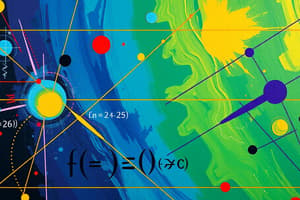Podcast
Questions and Answers
What does kinematics primarily focus on?
What does kinematics primarily focus on?
- The relationships between displacement, velocity, acceleration, and time (correct)
- The forces that cause motion
- The type of motion an object experiences
- The energy transformations during motion
What does the equation $vf = vi + at$ represent in kinematics?
What does the equation $vf = vi + at$ represent in kinematics?
- The equation for calculating work done
- The calculation of average velocity
- The formula for displacement
- The relationship between final velocity and initial velocity over time with acceleration (correct)
In one-dimensional motion, what do negative velocity values indicate?
In one-dimensional motion, what do negative velocity values indicate?
- The object is moving upward
- The object is at rest
- The object's acceleration is negative
- The object is moving backward (correct)
Which equation can be used to calculate displacement when acceleration is known?
Which equation can be used to calculate displacement when acceleration is known?
What do the subscripts 'i' and 'f' stand for in kinematic equations?
What do the subscripts 'i' and 'f' stand for in kinematic equations?
Why might separate equations be needed in kinematics?
Why might separate equations be needed in kinematics?
What role does gravity play in free fall?
What role does gravity play in free fall?
What is the main characteristic of two-dimensional motion?
What is the main characteristic of two-dimensional motion?
Flashcards
Kinematics
Kinematics
Describes motion without considering the forces that cause it.
Displacement (Δx)
Displacement (Δx)
The change in position of an object.
Velocity (v)
Velocity (v)
The rate of change of position with respect to time.
Acceleration (a)
Acceleration (a)
Signup and view all the flashcards
Time (t)
Time (t)
Signup and view all the flashcards
One-Dimensional Motion
One-Dimensional Motion
Signup and view all the flashcards
Two-Dimensional Motion
Two-Dimensional Motion
Signup and view all the flashcards
Free Fall
Free Fall
Signup and view all the flashcards
Study Notes
Kinematic Equations
- Kinematics describes motion without considering the forces causing it.
- It focuses on the relationships between displacement, velocity, acceleration, and time.
- Five fundamental kinematic equations apply to objects moving with constant acceleration, such as free-falling objects.
Key Variables
- Displacement (Δx): Change in an object's position.
- Velocity (v): Rate of change of position with respect to time.
- Acceleration (a): Rate of change of velocity with respect to time.
- Time (t): Duration of the motion.
Equations of Motion
- Final velocity (vf) = Initial velocity (vi) + acceleration (a) × time (t)
- Displacement (Δx) = Initial velocity (vi) × time (t) + ½ × acceleration (a) × time2 (t2)
- Final velocity2 (vf2) = Initial velocity2 (vi2) + 2 × acceleration (a) × displacement (Δx)
- Acceleration (a) = (Final velocity (vf) – Initial velocity (vi)) / time (t)
- Displacement (Δx) = ½ × (Final velocity (vf) + Initial velocity (vi)) × time (t)
Considerations
- Kinematic equations assume constant acceleration.
- Non-constant acceleration requires separate equations for different time intervals.
- Velocity and acceleration directions are critical; positive/negative signs indicate direction (often upwards is positive).
- Subscripts "i" and "f" denote initial and final values, respectively.
Applications
- Calculating a car's final velocity during highway acceleration.
- Determining the maximum height of a vertically thrown ball.
- Predicting a projectile's position at any given time.
- Analyzing motion in scenarios with constant acceleration.
One-Dimensional Motion
- Describes motion along a single axis (often x-axis).
- Velocity and acceleration can be positive or negative, indicating direction.
- Example: A car moving along a straight road.
Two-Dimensional Motion
- Describes motion in two perpendicular directions (commonly x and y).
- Motion breaks down into independent x and y components.
- Useful in projectile motion problems.
- Example: A ball thrown into the air; the x-component is affected by initial horizontal velocity, y-component by gravity.
Free Fall
- A special case of one-dimensional motion with only gravitational acceleration.
- Acceleration due to gravity (g) is approximately 9.8 m/s² downwards.
- Ignoring air resistance, all objects fall with the same acceleration, regardless of mass.
- Kinematic equations analyze free-fall motion.
Important Concepts
- Vector quantities (displacement, velocity, acceleration) have magnitude and direction.
- Scalar quantities (time, speed) have only magnitude.
- Speed is scalar; velocity is a vector including direction.
- Initial conditions (initial position, initial velocity) are essential for applying kinematic equations.
- Non-constant acceleration problems require calculus (integration/differentiation).
Studying That Suits You
Use AI to generate personalized quizzes and flashcards to suit your learning preferences.




